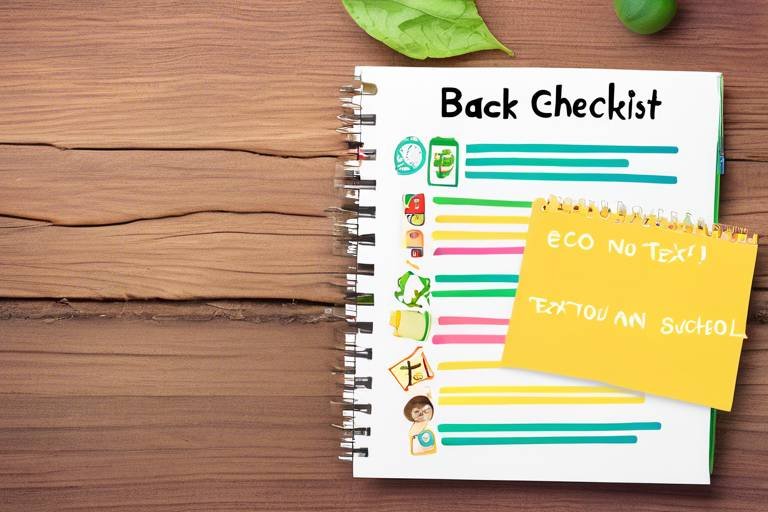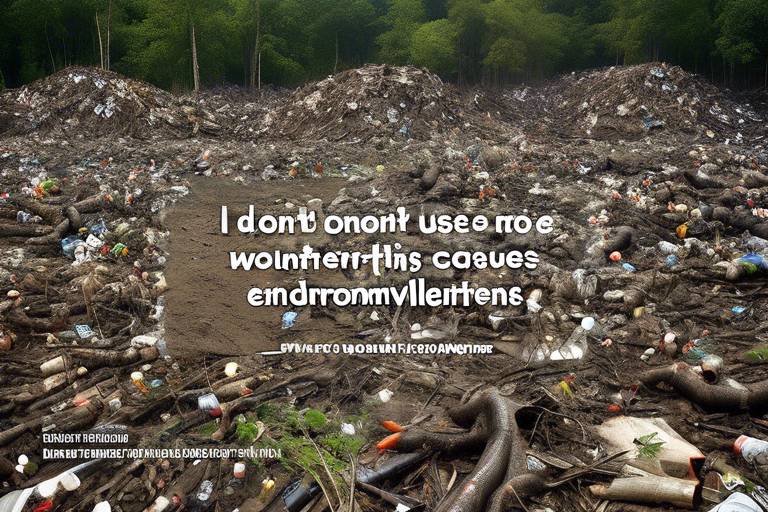How to Create an Eco-Friendly Back-to-School Checklist
Are you ready to kick off the new school year with a sustainable twist? Creating an eco-friendly back-to-school checklist is not only beneficial for the planet but also sets a positive example for the younger generation. By incorporating environmentally conscious practices into your back-to-school routine, you can make a significant impact on reducing waste and promoting a greener lifestyle.
When developing your eco-friendly checklist, consider starting with the basics – reusable school supplies. Opt for items like refillable pens, recycled paper notebooks, and reusable lunch containers. These alternatives not only minimize single-use plastic waste but also promote sustainable consumption habits among students.
Another key aspect of an eco-friendly back-to-school checklist is going paperless whenever possible. Embrace digital tools for organizing schedules, assignments, and notes to reduce paper consumption. By lessening the environmental impact of printing, you can contribute to conserving valuable resources.
Planning for sustainable transportation options is also crucial. Encourage walking, biking, carpooling, or using public transportation to and from school. Not only does this help decrease carbon emissions, but it also promotes healthier commuting habits for students.
When it comes to packing lunches, aim for zero-waste solutions. Use reusable containers, cloth napkins, and choose fresh, unpackaged foods to cut down on disposable plastic wrappers. This practice not only reduces landfill waste but also encourages mindful eating habits among children.
Teaching your child about energy conservation practices is essential. Educate them on turning off lights, unplugging electronics, and conserving water. By instilling these eco-conscious habits early on, you are nurturing a more sustainable mindset in the next generation.
Supporting second-hand shopping is another way to promote sustainability. Explore thrift stores, online marketplaces, and clothing swaps for gently used school attire and supplies. By giving these items a second life, you are contributing to reducing textile waste and supporting a circular economy.
Engaging in environmental education is key to fostering a deeper understanding of sustainability. Integrate lessons on climate change, conservation, and environmental stewardship into your child's learning. By doing so, you are nurturing environmental literacy and a sense of responsibility towards the planet.
Lastly, don't forget to involve the school community in your eco-friendly efforts. Collaborate with teachers, administrators, and fellow parents to advocate for green initiatives such as recycling programs and composting efforts. By working together, you can create a more sustainable school environment for everyone.

Choose Reusable School Supplies
When it comes to selecting school supplies for your child, opting for reusable and eco-friendly alternatives can make a significant impact on reducing waste and promoting sustainability. Instead of constantly buying new items that contribute to single-use plastic waste, consider investing in products that can be used multiple times.
One excellent choice is to switch to refillable pens or markers. Not only do these pens produce less plastic waste, but they can also save you money in the long run as you only need to purchase ink refills instead of entirely new pens. Additionally, choosing notebooks made from recycled paper helps to reduce the demand for virgin paper production, which in turn conserves trees and reduces energy consumption.
When packing your child's school bag, opt for reusable lunch containers instead of disposable plastic bags or wraps. These containers are not only better for the environment but also keep food fresh and prevent unnecessary waste. Consider using cloth napkins instead of paper ones, as they can be washed and reused multiple times, further cutting down on paper consumption.
Another great way to choose reusable school supplies is by looking for items that have a longer lifespan. Investing in a durable backpack made from sustainable materials can last for several school years, reducing the need for frequent replacements. Similarly, choosing quality stationery items that can be used for an extended period helps to minimize the amount of waste generated.

Go Paperless Whenever Possible
When it comes to creating an eco-friendly back-to-school checklist, going paperless whenever possible can make a significant impact on reducing waste and promoting sustainability. By embracing digital tools and technology, you can not only streamline your organizational processes but also contribute to a greener environment.
Imagine a world where traditional paper-based systems are replaced by efficient digital platforms that allow you to manage schedules, assignments, and notes with just a few clicks. This shift not only reduces the need for paper production but also minimizes the environmental impact of printing, saving countless trees in the process.
Transitioning to a paperless approach not only benefits the planet but also offers practical advantages for students and parents alike. With digital calendars, apps, and online resources, you can access information anytime, anywhere, without the need for bulky notebooks or printed materials.
Moreover, going paperless encourages a mindset of minimalism and efficiency, prompting individuals to prioritize essential information and declutter their physical spaces. By reducing paper consumption, you are not only contributing to environmental conservation but also fostering a more organized and streamlined lifestyle.
Additionally, the convenience and accessibility of digital tools make it easier to collaborate and share resources with classmates, teachers, and parents. Whether it's submitting assignments online, participating in virtual study groups, or accessing educational materials remotely, the benefits of going paperless extend beyond sustainability to enhance overall learning experiences.

Plan Sustainable Transportation Options
When it comes to planning sustainable transportation options for your back-to-school routine, there are several eco-friendly choices you can consider. Opting for environmentally conscious ways of getting to and from school not only helps reduce carbon emissions but also promotes healthier commuting habits. One effective strategy is to encourage walking or biking if the distance allows. Not only does this reduce pollution, but it also benefits your child's physical health by incorporating exercise into their daily routine.
Another sustainable transportation option is carpooling with other families in your neighborhood. By sharing rides, you can decrease the number of vehicles on the road, leading to less congestion and lower emissions. Additionally, carpooling can help build a sense of community among parents and students while reducing the overall environmental impact of individual car trips.
If walking, biking, or carpooling is not feasible, consider using public transportation as a greener alternative to driving. Public transit systems help minimize the number of cars on the road, contributing to improved air quality and reduced traffic congestion. By utilizing buses, trains, or other public transportation modes, you can lower your carbon footprint and support sustainable urban mobility.
When planning sustainable transportation options, it's essential to involve your child in the decision-making process. By discussing the environmental benefits of walking, biking, carpooling, or using public transportation, you can instill a sense of responsibility and eco-consciousness in your child. Encouraging them to actively participate in choosing sustainable transportation methods fosters a deeper appreciation for the environment and the importance of reducing carbon emissions.

Pack Zero-Waste Lunches
When it comes to creating an eco-friendly back-to-school checklist, one essential aspect to consider is how to pack zero-waste lunches. This involves making conscious choices to minimize the amount of waste generated from your child's daily meals. By opting for reusable containers instead of disposable ones, you can significantly reduce the use of plastic wrappers and packaging materials that often end up in landfills.
Additionally, using cloth napkins instead of paper ones can further contribute to a zero-waste lunch routine. By incorporating fresh, unpackaged foods into your child's meals, you not only promote healthier eating habits but also reduce the overall environmental impact of their lunchtime choices. Choosing whole fruits instead of pre-packaged snacks and homemade sandwiches over store-bought options can make a significant difference in cutting down on waste.
Furthermore, involving your child in the process of packing zero-waste lunches can be a fun and educational experience. You can discuss the importance of reducing waste, explain how certain packaging materials harm the environment, and encourage them to come up with creative ways to make their lunches more sustainable.
Consider setting up a designated area in your kitchen stocked with reusable containers, cloth napkins, and bulk food items to make packing zero-waste lunches a convenient and accessible practice. By establishing a routine and involving your child in the preparation process, you can instill lifelong habits that prioritize sustainability and environmental consciousness.

Teach Energy Conservation Practices
Teaching energy conservation practices to your child is not only beneficial for the environment but also helps instill valuable habits that promote sustainability. By incorporating simple yet effective strategies into your daily routine, you can actively contribute to reducing energy consumption and minimizing your carbon footprint.
One approach to teaching energy conservation is through practical demonstrations. Show your child how turning off lights when leaving a room or unplugging electronic devices when not in use can significantly save energy. Create a fun and interactive challenge to see who can remember to switch off appliances and lights, turning it into a game can make learning about energy conservation enjoyable for your child.
Additionally, involve your child in activities that promote energy efficiency, such as setting up a family energy-saving plan. Create a chart or table to track energy usage and savings over time, highlighting the positive impact of simple actions like using natural light during the day or adjusting the thermostat to conserve energy.
Furthermore, educate your child on the importance of conserving water, another crucial aspect of energy conservation. Discuss the connection between water usage and energy consumption, and encourage practices like taking shorter showers, fixing leaky faucets promptly, and using dishwasher and laundry machines efficiently to reduce energy-intensive water heating processes.
Integrating energy conservation practices into your child's daily routine not only benefits the environment but also helps develop a sense of responsibility and awareness towards sustainable living. By making energy conservation a part of everyday life, you are empowering your child to become a conscious consumer and advocate for environmental stewardship.

Support Second-Hand Shopping
When it comes to supporting second-hand shopping for back-to-school needs, you're not only making an eco-conscious choice but also contributing to reducing textile waste and extending the lifespan of items. By exploring thrift stores, online marketplaces, and participating in clothing swaps, you can find gently used school attire and supplies that are both affordable and sustainable. Embracing second-hand shopping promotes a circular economy where resources are reused, lessening the demand for new products and minimizing the environmental impact of manufacturing and disposal.

Engage in Environmental Education
Engaging in environmental education is a crucial step towards raising awareness and fostering a sense of responsibility towards the planet. By integrating lessons on sustainability, climate change, and conservation into your child's learning experience, you are not only enriching their knowledge but also shaping their values for a greener future. Environmental education goes beyond textbooks and classrooms; it involves hands-on experiences, discussions, and practical applications that inspire a deeper connection to the natural world.
One effective way to engage in environmental education is by incorporating nature-based activities into your child's routine. Whether it's planting a garden, going on nature walks, or participating in community clean-up events, these experiences allow children to witness firsthand the beauty of the environment and understand the importance of preserving it. By immersing them in nature, you can instill a sense of wonder and appreciation that will stay with them for a lifetime.
Furthermore, encouraging curiosity and critical thinking about environmental issues can spark meaningful conversations and encourage children to ask questions about the world around them. By nurturing their inquisitive minds and providing opportunities for exploration, you can empower them to become informed and proactive stewards of the environment.
Engaging in environmental education also involves setting a positive example as a role model. By demonstrating sustainable practices in your daily life, such as recycling, conserving energy, and reducing waste, you show your child the importance of living in harmony with the planet. Actions speak louder than words, and by embodying eco-friendly behaviors, you inspire your child to follow suit and make environmentally conscious choices.
Remember, environmental education is not just a one-time lesson but an ongoing journey of learning and growth. By embracing opportunities to educate, inspire, and lead by example, you can empower the next generation to become informed and engaged environmental advocates.

Involve the School Community
When it comes to creating an eco-friendly back-to-school checklist, involving the school community can make a significant impact on promoting sustainable practices. By collaborating with teachers, administrators, and fellow parents, you can advocate for various eco-friendly initiatives that contribute to a greener school environment.
One way to involve the school community is to push for comprehensive recycling programs within the school premises. Encouraging proper waste segregation and recycling practices can significantly reduce the amount of waste that ends up in landfills, promoting a more sustainable approach to waste management.
Additionally, organizing composting efforts at the school can be a valuable initiative. Composting organic waste from the cafeteria or school gardens not only reduces the volume of trash but also creates nutrient-rich soil that can be used for gardening projects, fostering a culture of sustainability within the school community.
Advocating for green school policies is another impactful way to involve the school community in promoting eco-friendly practices. This can include initiatives such as energy-saving measures, water conservation programs, and the implementation of eco-friendly cleaning products to reduce the school's overall environmental footprint.
Furthermore, organizing educational workshops and awareness campaigns within the school community can help raise awareness about the importance of sustainability. By engaging students, teachers, and parents in discussions about environmental issues, you can inspire collective action towards a more eco-conscious school environment.
Frequently Asked Questions
- What are some eco-friendly school supplies I can include in my back-to-school checklist?
Consider options like refillable pens, recycled paper notebooks, and reusable lunch containers to reduce single-use plastic waste and promote sustainability.
- How can I encourage my child to adopt energy conservation practices?
You can educate your child about turning off lights, unplugging electronics, and conserving water to instill eco-conscious habits that contribute to a greener lifestyle.
- Why is it important to involve the school community in eco-friendly initiatives?
Collaborating with teachers, administrators, and parents can help advocate for programs like recycling, composting, and green policies, creating a more sustainable school environment.



















